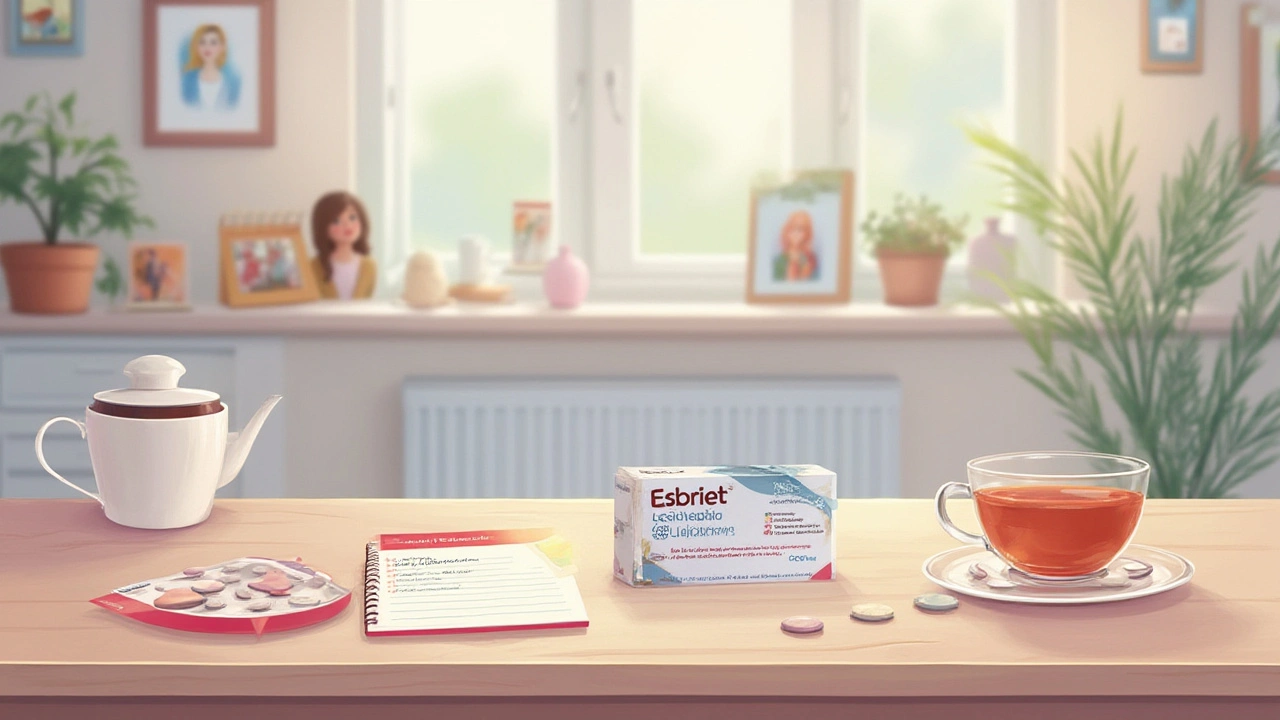
Coughing so much you’re gasping for breath isn’t normal, but for people with idiopathic pulmonary fibrosis (IPF), it could be an everyday thing. Imagine stubborn scar tissue tightening around your lungs, making each inhale a struggle. That’s what happens with IPF; it’s like trying to breathe through a straw that keeps getting smaller. In the last decade, a medicine called Esbriet came onto the scene with big promises. But what does it really do? Does it help you breathe easier, or just come with a list of side effects as long as your arm?
Doctors used to shake their heads in frustration when diagnosing someone with IPF—there was very little they could offer. Esbriet changed that. This isn’t just a pill; it’s a shot at keeping your breath, your hobbies, and your independence for longer.
How Esbriet Works for Idiopathic Pulmonary Fibrosis
Esbriet, known by the generic name pirfenidone, isn’t a miracle cure—but it does slow down the lung damage in idiopathic pulmonary fibrosis. Think of it as putting the brakes on a runaway train. You’re not going to stop it, but you might slow it just enough to make a real difference. IPF causes inflammation and then relentless scar tissue in the lungs. Scarred areas can’t get oxygen into your blood well. Esbriet works by fighting the inflammation and reducing the formation of scar tissue, but researchers are still piecing together all the ways it does this.
If you’re picturing a medicine that rebuilds healthy lung tissue, that’s not Esbriet’s thing. It won’t reverse the scarring, but what it’s been shown to do—across several large clinical trials—is help slow down how fast the scarring gets worse. One pivotal trial called CAPACITY followed people with IPF for almost two years. By week 72, those taking Esbriet lost less lung function than those on a placebo—something measurable using a spirometry test called FVC (forced vital capacity). Here’s how it stacked up:
| Study Group | Average FVC Loss after 72 Weeks (ml) |
|---|---|
| Esbriet | 235 |
| Placebo | 428 |
While that difference might sound small, ask anyone who has struggled for air—every bit counts. For some, it’s the difference between going to the grocery store on their own or needing help.
It’s taken by mouth, typically three times a day. You start on a low dose, then ramp it up over two weeks, giving your body a chance to adjust and lowering the risk of side effects. You need to take it with food, or your stomach may punish you later. And, if you’re out enjoying a sunny day, grab a hat—Esbriet doesn’t play nice with sunlight and can make you burn easier than you think.
Cost is a biggie. In the U.S., a month of Esbriet could set you back thousands of dollars without insurance. Many health plans help, as do support programs from the manufacturer. If you’re outside the U.S., coverage varies a lot, so it’s worth calling your local healthcare system or insurance provider for the real deal.
What about the real-world differences people notice? Some folks report improved cough; for others, it’s just nice knowing they’re doing something to fight back. Just remember, you won’t "feel" Esbriet working day to day—it’s more about maintaining what you have for as long as possible.

Side Effects and How to Handle Them
No pill is perfect, and Esbriet is no exception. The most common side effects aren’t exactly fun: many users report nausea, fatigue, stomach upset, and sensitivity to sunlight. Some people also experience rashes, diarrhea, and loss of appetite. Don’t panic; these effects don't strike everyone—and there are practical ways to deal with most of them.
Nausea usually hits harder when you start. Taking the pill with a good meal or snack can really help. Avoid spicy or greasy foods; you’ll thank yourself later. Fatigue might sneak up after a few weeks. It’s not like the exhaustion from a bad flu, more like a heavy blanket you can’t quite shrug off. If you feel wiped out, listen to your body and rest when you need to. Hydration is your friend here, as well as light, regular activity—think walking, not weightlifting championships.
Sun sensitivity is a big issue, and it’s not a joke: Esbriet can make your skin super reactive to sunlight. Even a short stroll outside can result in a surprising sunburn. Hat, sunglasses, long sleeves, and sunscreen (SPF 50+ recommended) aren’t just suggestions—they’re necessities if you’re taking Esbriet. Some people find they only need to get serious about sun protection in the summer, but it’s safer to make it a year-round habit.
Some users report GI side effects like heartburn or diarrhea. Taking the medicine with food—never on an empty stomach—really helps. If diarrhea becomes a regular thing, try smaller meals more often, and stay hydrated. For those battling loss of appetite or weight loss, make meals more appealing with favorite foods, shakes, or smoothies. Don’t be shy about talking with a nutritionist; they can work wonders with a tailored eating plan.
You’ll also need regular blood tests when on Esbriet. Doctors want to see your liver is handling the drug, because rare but serious liver problems have happened. Watch for dark urine, yellow skin or eyes, or right side abdominal pain—these are signals you need your doctor on speed dial. Staying proactive can help keep little problems from turning into big ones.
For a minority, Esbriet just won’t be worth it—the side effects may be too much, or blood tests may show it’s not safe to continue. There’s another IPF drug, nintedanib (Ofev), which some people switch to. Combo therapy isn’t recommended yet; there’s not enough evidence it makes things better.

Practical Tips for Living with Esbriet
Taking a drug three times a day isn’t easy to remember, especially when life gets complicated. Setting reminders on your phone, or linking doses to meals (breakfast, lunch, and dinner), is a good start. Forget a pill? Take it as soon as you remember, unless it’s almost time for the next one—then just skip. Doubling up isn’t a good idea; it just ups your odds of feeling bad.
If nausea, sun sensitivity, or other side effects are tough in the first month, don’t tough it out alone. Your doctor can often suggest tweaks—splitting the dose with meals, swapping up the time of day, or trying anti-nausea meds. Sometimes a temporary pause helps your body catch up, and you can try again at a lower dose.
For sun protection, stash a hat and sunscreen in your car, bag, or by the front door. Get in the habit of applying sunscreen even on cloudy days—UV rays don’t care about clouds. If you have to be outdoors for work or errands, look for lightweight UPF-rated clothing. It’s also smart to avoid sun exposure between 10 a.m. and 4 p.m., when rays are harshest.
Stick to honest conversations with your doctor. If you miss doses, say so—no judgment, just teamwork. If side effects get out of hand, speak up early. Changes to dose or schedule often help, and you won’t be the first one to ask.
Beyond just the medicine, building healthy routines matters. Pulmonary rehab programs teach you practical breathing exercises, energy-saving tricks, and ways to stay active within your limits. A little support goes a long way, whether it’s through online forums, local support groups, or family and friends. Many find it helps to write down their experiences, tracking everything from daily symptoms to how well side effects are managed. Looking back over months, you might spot patterns that help your doctor make better treatment decisions with you.
One last tip: traveling with Esbriet is possible, but plan ahead. Carry extra medication in your hand luggage, and pack a medical letter explaining why you need it—especially for trips abroad. Bring your sun protection kit, and scout out local pharmacies just in case. If you cross time zones, keep your dose schedule regular, even if you need to reset your reminders.
Living with IPF isn’t easy, and Esbriet isn’t magic. But it does give patients and families another tool to take back a little control. With good info, solid routines, and some grit, you can wring more good days out of every week.

Honestly, I can’t help but wonder if the pharmaceutical companies are really upfront about all the side effects of Esbriet. I’ve read some reports online that seem to get buried in official documentation.
There’s always this fog around meds like these, you know? People are told about common side effects but what about the really rare, potentially serious ones? And how well do doctors actually communicate those risks?
Idiopathic pulmonary fibrosis is brutal, and while Esbriet might slow it down, I’d be cautious and really push for thorough monitoring. Has anyone here experienced unexpected side effects or perhaps noticed something their doctor didn’t mention?
I’m just skeptical until I see more transparent data. It feels like we’re sometimes guinea pigs in this game.
Anyway, that’s my two cents. Always question and stay informed.
Thanks for sharing all the important info about Esbriet. It’s true, this condition can be really tough for patients.
From what I’ve learned, the benefits of Esbriet in slowing disease progression are promising, even if it’s not a cure. That alone can mean a lot for the quality of life.
Side effects like nausea and fatigue are a bother, but worth it if it helps keep lungs working a bit longer. I encourage anyone taking it to keep communicating with their doctors and keep positive.
Does the post mention lifestyle tips? That often helps too, like breathing exercises or mild activity.
We need more optimism around treatments like this. Small steps matter.
Wow, I've been on Esbriet for almost a year now and this overview sums it up pretty well.
One thing I'd add is that staying hydrated and managing side effects with your healthcare team is crucial. The fatigue can hit hard, and sometimes you feel like your lungs just won't cooperate no matter what.
Also, I found talking to support groups helps so much emotionally. Knowing others are going through the same things makes it a bit easier to handle.
The post's practical tips are valuable too — little reminders that managing this disease is a daily effort.
Anyone else noticed any strange interactions with other meds while on Esbriet?
Alright, let’s be real here. Esbriet isn’t some miracle cure, but it’s also not snake oil.
People taking it need to have realistic expectations. This drug can slow fibrosis progression, but it doesn't reverse damage already done.
Side effects are no joke though — nausea, rash, and liver issues mean you gotta be on your toes and in close touch with your doc.
The tips for managing side effects could use more detail — I'm talking specifically about how to handle nausea naturally or with supplements.
Anyone here tried complementary methods alongside Esbriet? I’m curious how that worked out.
Reading through this really helped me understand what my dad is going through. He just started Esbriet last month.
The side effects worried me initially, but it sounds manageable with the right care and monitoring.
Thanks for including lifestyle tips, they’re often overlooked but so important.
Does anyone know how long before seeing noticeable benefits? Dad’s encouraged but anxious about the wait.
It's good that this post sheds light on a condition many don’t talk about.
Great post. I just want to highlight that consistency in taking Esbriet is key. Missing doses can reduce effectiveness significantly.
Also, watch your liver function tests closely. Some patients overlook this but it’s critical with this medication.
For anyone struggling with side effects, don’t hesitate to speak with your doctors about possible dose adjustments or supportive meds.
Finally, make sure your nutrition is solid — your body needs all the support it can get.
What struck me most about Esbriet is how it represents a beacon of hope amid the smog of despair that pulmonary fibrosis often casts over patients’ lives.
It’s a scientific marvel in its way, using antifibrotic properties to slow down an otherwise relentless process. Of course, it’s not without its shadow side effects, which remind us of the delicate balance in medicine.
However, beyond the clinical facts lies the human heart — patients striving to hold onto breath and life.
I appreciate posts like this that blend hard facts with real-world advice, helping people navigate both the physical and emotional landscapes of their journey.
It encourages not just treatment but resilience.
Esbriet works by inhibiting fibrosis, plain and simple. It doesn’t cure, but it slows the pace.
The side effects need management, nothing complex about that. It’s about balance, care, and attention.
Patients must engage with their medical teams in trust, understanding the limits and potentials.
The philosophical side: this reminds us that some battles are measured in months, not cures.
In the end, treatment is also a dialogue — between patient, doctor, and body.
This is just another overhyped drug pushing profits over patients. The side effects are glossed over, and the 'practical tips' here are basically filler.
Esbriet is expensive and full of complications. People deserve honesty, not glossy brochures.
Why not focus on prevention or better diagnostics instead of this endless cycle of expensive med treatments?
Honestly, I find these posts irritatingly one-sided and uncritically supportive of big pharma.
Anyone else see this as a marketing move rather than real patient support?
While I understand the negative sentiments, it’s worth remembering that any intervention that offers even partial relief or slows disease progression is valuable.
Patients often face a bleak prognosis and any drug like Esbriet can serve as a lifeline.
Medical treatments always carry risks, but with careful attention, benefits can outweigh harms.
It’s about informed choice, not blind acceptance.
Dialogue like we are having now is essential for progress.
@367 I get where you’re coming from, but I think there’s merit in these medications for some people.
Yes, cost and side effects are issues, but that's the reality for many treatments in serious diseases.
Sharing detailed info and real-life tips helps patients make better choices and cope, which is incredibly valuable.
We need honest discussions like this balancing skepticism and hope.
Support is critical, not just criticism.